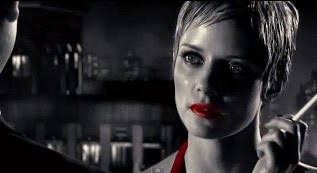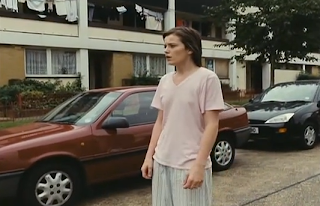 The character roles fit into the typical conventions of the film noir genre, including femme fatales, cynical protagonists and corrupted characters.
The character roles fit into the typical conventions of the film noir genre, including femme fatales, cynical protagonists and corrupted characters.The lead protagonist 'the driver', shows very similar characteristics to the classic noir protagonists. 'The driver' is shown as being lonely with minimal dialogue. Goslings facial expression remains predominantly the same, showing a lack of emotion, giving an impression that he is in an un-stable mental state. In most texts, Noir protagonists are usually mentally or physically damaged, which reflects a trauma from a previous experience. Throughout the film, Gosling's character is not named, and only referred to as 'the driver', which suggests his lack of self value and his only purpose as a criminal get-away driver.
He does not value himself and acts to save the female (Irene). He is willing to sacrifice himself to ensure Irene is safe, proving his selflessness. This is evidenced when he and Irene are in the lift, when confronted by a man planning to kill them, however 'the driver' kills the man to ensure Irene's safety. Classic protagonists usually have a femme fatale they protect, however, they drag them into dangerous situations. These aspects are typical of a classic noir protagonist. The femme fatale character, Blanche, double crosses 'the driver', which creates fears of mis-trust and paranoia.
Narrative themes:
'The driver' is an anti-hero as he has no fatal flaw, and works to protect Irene and her son through acts of violence. Gosling's character has no desire for money or his own well-being, with his main purpose to protect Irene.
'The driver' is an anti-hero as he has no fatal flaw, and works to protect Irene and her son through acts of violence. Gosling's character has no desire for money or his own well-being, with his main purpose to protect Irene.
Blanche double crosses 'the driver', which creates a sense of paranoia. She informs the villains about the planned robbery, and also reveals their location, which results in her death, showing her naivety and lack of power.
Technical codes:
The beginning of the clip features Irene's face half cast in shadow, showing that she may have a corrupt side, which is a common noir convention. This mimics the 2005 hit film 'Sin City', as in the opening scene a similar lighting technique is shown on 'the assassin'. This is a technical code, in addition to the sinister music creating a binary opposition, as she is re-telling the story of how she met her husband. However, the clip has an eerie feel and tells the viewer that something bad is going to happen soon. This is confirmed when her husband is killed in the pawn shop robbery. This is shown through flashback, which is a very common film noir genre convention. Throughout the scene, low key lighting is used to show the corruptness and paranoia of the characters, in particular the lead protagonist, 'the driver'. After 'the driver' has just killed 2 people, his face is bloody and lit well in high key lighting with darkness around him, he then steps backwards into the shadow, therefore creating low key lighting on his face and body. This is an uncommon feature of a noir protagonist, as it shows his criminality and deceit.Technical codes:
Iconography and mise-en-scene:
The iconography of 'Drive' mimics the noir genre throughout. Many urban environments are used, in addition to a strip club and neon lights, which convey danger. Low key lighting is used to show the two sides to the characters, including 'the driver' and Blanche. The split lighting on their faces show their good side vs their corrupt side. We see this when 'the driver' commits an act of violence, however for a good reason to protect Irene. The split lighting shows the 2 sides to him, showing him as an anti-hero. Venetian blinds are also used, which is a large iconic visual convention used in film noir. Blanche is seen smoking which is another popular genre convention.
Short conclusion:
From just a short scene from the film, it is very apparent that the film contains many classic genre conventions from the film noir genre, although it is not classed as being part of the film noir genre, many conventions create noir themes.


















